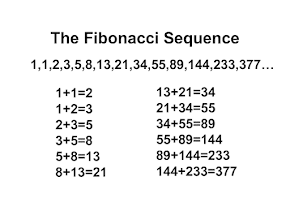FIBONACCI NUMBERS
Fibonacci Numbers
Leonardo Bonacci known as Fibonacci was an Italian mathematician, born around 1176 considered to be the most talented Western mathematician of the middle ages.
Fibonacci travelled extensively around the Mediterranean coast, meeting with many merchants and learning of their systems of doing arithmetic. Fibonacci popularised the Hindu-Arabic numerical system to the western world primarily through his composition in 1202 of Liber Abaci(Book of Calculation).
He solved a problem involving the growth of a population of rabbits based on idealised assumptions. The solution generation by generation was a sequence of numbers later known as Fibonacci numbers.
Fibonacci considers the growth of an idealised (biologically unrealistic), rabbit population, assuming that a newly born pair of rabbits, one male, one female are put in a field, rabbits are made to mate at the age of one month so that at the end of its second month a female can produce another pair of rabbits, rabbits never die and mating pair always produces one new pair (one male,one female) every month from the second month on. The puzzle l that Fibonacci posed was how many pairs will there be in one year?
- At the end of the first month, they mate, but there is still 1 pair.
- At the end of the second month, the female produces a new pair, so now there are 2 pairs of rabbits in the field.
- At the end of third month, the original female produces a second pair, making 3 pairs in all in the field.
- At the end of fourth month, the original female has produced yet another new pair, the female born two months ago produces her first pair also, making 5 pairs.
At the end of the nth month the number of pairs of rabbit is equal to the number of new pairs plus the number of pairs alive last month. This is the nth Fibonacci number.
By definition the first two numbers in the Fibonacci numbers in the Fibonacci sequence are either 1 and 1 or 0 and 1, depending on the chosen starting point of the sequence and each subsequent number is the sum of the previous two.
1,1,2,3,5,8,13,21,34,55,...
.png)
Fibonacci Numbers in Nature
Fibonacci sequence appear in biological settings such as branching in trees phyllotaxis, the arrangement of leaves on a stem, the fruitlets of pineapple, the flowering of artichoke, an uncurling fern and the arrangement of pine cone. In addition numerous poorly sustained claims of Fibonacci numbers or golden section in nature are found in popular sources. For example, relating to the breeding of rabbits, the seeds on a sunflower, the spiral of shells and the curve of waves.
FLOWERS
On many plant, the number of petals is Fibonacci number. Buttercups have 5 petals, lilies and iris have 3 petals, some delphiniums have 8, cone marigold have 13 petals and some asters have 21 whereas daisies can be found with 34, 55 or even 89 petals.
The sunflower is a perfect example of the Fibonacci sequence and the corresponding golden ratio appearing in nature. Firstly, see how the florets are arranged in a spiral pattern both in a clockwise and counter clockwise fashion. There are 34 spirals that turn clockwise and 21 spirals that turns the counter clockwise. The counter clockwise spirals appear to grow according to the golden ratio. An approximate measure of this is that the radius of the spiral doubles with every 90 degree of rotation.
Arrangements in Leaf
Many plans show the Fibonacci numbers in the arrangements of the leaves around their stems. If we look down on a plant, the leaves are often arranged so that the leaves above do not hide lives below. This means that each gets a good share of the sunlight and catches the most rain to channel down to the roots as it runs down the leaf to the stem.
The Fibonacci numbers occur when counting both the number of times we go around the stem, going from leaf to leaf as well as counting the leaves we meet until we encounter a leaf directly above the starting one. If we count the other direction, we get a different number of turns of the same number of leaves.
Animals
Dolphins are an example of Fibonacci sequence in nature: 1 fin on top, 1 tail, 2 side fins, 3 fins total( for example). The eye fins and tail of dolphin all have the Golden Ratio.
Art and Architecture
Da Vinci utilized the sequence with the Golden Spiral which stem from the Perfect Rectangle. The Perfect Rectangle is formed by creating rectangles within the corresponding dimensions of 1.618, from each descending Fibonacci numbers (...8,5,3,2,1,1).
.png)
.png)
.jpeg)
.png)
.jpeg)
.jpeg)
.jpeg)
Comments
Post a Comment